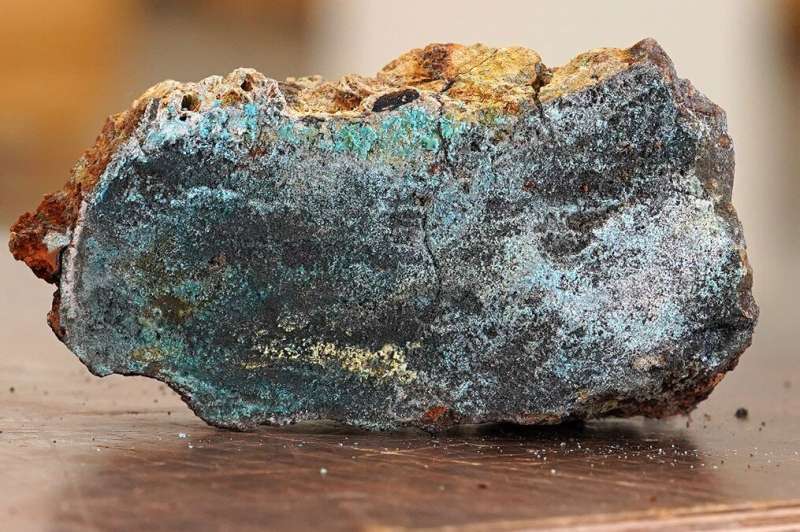This article has been reviewed according to Science X's editorial process and policies. Editors have highlighted the following attributes while ensuring the content's credibility:
fact-checked
trusted source
proofread
Artificial geysers can compensate for our mineral shortages

By imitating nature, it may be possible to recover seabed minerals by extracting hot water from the Earth's crust. We can harvest green energy and be sensitive to the environment—all at the same time.
Seabed minerals: Here's something you probably don't know. The copper found in the Norwegian mines at Røros and Løkken, and which once made the country very wealthy, was formed from smoking "chimneys" on the ocean floor.
In the Earth's remote past, this copper was carried up through the crust by seawater that had originally been drawn downwards into the scorching depths. If we humans can learn to imitate part of this process, it may be possible to apply it to sensitively recover a variety of minerals from the oceans offshore Norway.
At SINTEF, we believe that seabed minerals should only be recovered if we can develop methods that minimize any negative environmental impacts. We are now in the process of identifying one such method.
Or, in other words, of obtaining the "building blocks" being called for by the green transition. At the same time, we can obtain valuable geothermal heat that we can convert into emissions-free energy.
From the scorching depths to the deck of a platform
In the heated debate currently raging about seabed minerals, now fueled once again by WWF's recent notification to sue the Norwegian state, many people have expressed their fear of negative ecological consequences resulting from the exploitation of these resources.
At SINTEF, we believe that seabed minerals should only be recovered if we can develop methods that minimize any negative environmental impacts. We are now in the process of identifying one such method.
Our idea is to transport the mineral-rich water and bypass the process of precipitation on the seabed, recovering the minerals directly from the scorching depths in the Earth's crust from where they originate. Extraction will take place on the deck of an offshore platform.
Water heated by molten rock
Below the sea surface, some distance from land, there are several locations where so-called black smoker geysers eject mineral-rich waters brought up from the depths of the crust.
This phenomenon is the result of water first having been drawn down into fractures in the volcanic rocks of the seabed and then all the way down into the mantle, which is the layer of molten rock lying beneath the crust. Here, the water is subject to intense heat and is able to take up particles of metals and minerals. These are exactly the materials we need to make our batteries, wind turbines and electric vehicle engines.
Then, the mineral-rich water rises from the mantle, through the crust, and up to the seabed, where it is ejected from the black smoker geysers.
Electricity from steam
At SINTEF, we are working on the idea of imitating part of this process by constructing artificial geysers. Firstly, by drilling wells for sending seawater down into the mantle—and then others for transporting the mineral-rich water back to the surface.
This water will be transported in pipes up to platforms where the particles will be separated.
The pressure at the Earth's surface will cause the water to boil. Our idea is to use the steam to generate electricity, which will then be sent onshore. The revenues from selling the electricity will be used to pay for parts of the mineral recovery process.
Discovered in the 1970s
SINTEF has been here before—demonstrating that imitating nature can be a very fruitful venture. Specifically, that the properties of underwater shales are ideal for dealing with abandoned oil wells.
The phenomenon that we are seeking to imitate today—these "black smokers" on the seabed—was discovered in the 1970s in an area of the Pacific Ocean at the boundary between two tectonic plates.
Many underwater geysers of this type have been identified on the Mid-Atlantic Ridge in Norwegian waters. These are locations where molten magma still occurs close to the seabed. Some of them are probably still active today.
Sulfide minerals
The smoker chimneys are made up of particles that are precipitated when the hot, mineral-rich water is ejected from the geysers into the cold seawater. Other fractions of the ejected mass of particles have sunk to the seabed, forming great mounds of gravel at the base of the chimneys.
As time passes, many of the chimneys stop ejecting. They seal up and die, tipping over onto the "piles of gravel."
These gravel piles represent the biggest and most concentrated occurrences of sulfide minerals on the seabed. The sulfide family is one of the two main groups of seabed minerals known from Norwegian oceans.
Key metals
According to the Norwegian Offshore Directorate, the natural geysers have deposited minerals containing key metals such as zinc, cobalt, nickel, vanadium, tungsten and silver. Not to mention copper, which occurs in concentrations much greater than those we encounter in mines onshore.
Our idea assumes that humans will succeed in drilling wells that can withstand the temperatures they will encounter close to bodies of molten rock. Experts are already working on this problem..
"Our concept will not be put into practice tomorrow, but it may not be too far into the future either. The timing will depend on the efforts that we are prepared to put into developing the idea. We still need more data about the subsurface, combined with some smart technological innovations.
Supply security for the green transition
If our idea succeeds, this will help the European Parliament, the Norwegian government and everyone else who is looking to safeguard supply security for the green transition.
We have great faith that our concept represents a sensitive and realistic approach to minerals recovery, and are looking forward to continuing with its development.
Provided by Norwegian University of Science and Technology





















